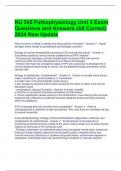NU 545 Pathophysiology Unit 3 Exam
Questions and Answers (All Correct)
2024 New Update
What hormone is linked to obesity and early puberty in females? - Answer ✔ · Higher
estrogen levels related to gonadotropin and estrogen secretion
Etiology of cervical intraepithelial carcinoma (CIN) and cervical cancer. - Answer ✔ ·
Exclusively caused by cervical human papillomavirus (HPV) infection
· Precancerous dysplasia (cervical intraepithelial carcinoma (CIN) and cervical
carcinoma (CIS) are more advanced forms of these cell changes)
· Infection with high risk (oncogenic) types of HPV are a precursor to development of
cervical dysplasia which leads to cancer; can be detected through examination of the
cervical cells
Etiology of epididymitis. Complications? - Answer ✔ · Occurs in sexually active young
males; caused by N. gonorrheoeae or C. trachomatis
o in older men, UTIs and prostatitis could cause it
o also caused by chemical inflammation caused by the reflux of sterile urine into the
ejaculatory ducts
· complications: abscess formation, infarction of testes, infertility
o infarction is caused by thrombosis secondary to inflammation
o chronic epididymitis causes scarring of the endothelium: once scarring has occurred,
treatment with antibiotics is ineffective because adequate levels cannot be achieved
within the epididymis
STI's in teenage girls-why are they more susceptible? - Answer ✔ · Risks of
unprotected sex or selection of high risk partners. Also, they have an increased risk due
to cervical immaturity.
Know pathophysiology, etiology, clinical manifestations, diagnostics, treatment, and
complications of endometriosis - Answer ✔ · Endometriosis is the presence of
functioning endometrial tissue outside of the uterus; these ectopic (out of place) tissues
respond to hormones of the menstrual cycle
· Etiology: implantation of endometrial cells during retrograde menstruation (menstrual
fluids go through fallopian tubes and into the pelvic cavity), impaired cellular and
humoral immunity (alterations in cytokine and growth factor, autoimmune response is
suspected), endometrial cells may spread through lymphatic or vascular systems
,· Patho: ectopic (out of place) endometrium proliferates, breaks down, and bleeds with
the menstrual cycle; this causes inflammation and triggers cytokines and leukocytes
which leads to fibrosis/scarring/pain
· Manifestations: infertility and pain, dyschezia (pain when pooping), dyspareunia (pain
with intercourse)
· Evaluation: definitive diagnosis requires laparoscopy; stage 1 (minimal), stage 2 (mild),
stage 3 (moderate); severity of pain is not indicative of the extent of endometriosis
· Goal: prevent progression, alleviate pain, restore fertility
· Treatment: suppression of ovulation, laparoscopic removal of endometriosis
Know how protein hormones are transmitted in the blood. - Answer ✔ · Peptide or
protein hormones are water soluble and circulate in free (unbound) forms; they are
catabolized by circulating enzymes and have a short half life
· Lipid soluble hormones (cortisol and adrenal androgens) are transported bound to a
carrier and can remain in the blood for hours/days
· Only free hormones can initiate changes within a target cell
o Target cell receptors have two main functions: recognize and bind to their particular
hormone, and to initiate a signal to appropriate intracellular effectors
Know ADH. Where is it secreted? Where does it act? - Answer ✔ · Major homeostatic
function of the pituitary is the control of osmolality which is regulated by ADH; acts on
vasopressin receptors of the renal tubular cells to increase their permeability which
leads to increased water absorption into the blood and concentrates the urine and
reduces serum osmolality
o Effects can be inhibited by hypercalcemia, prostaglandin E, and hypokalemia
· Secretion of ADH is regulated by the hypothalamus
o Plasma osmolality increases which increases ADH secretion and more water is
absorbed from the kidney, plasma is diluted
o ADH has no direct effect on electrolytes but with increased water absorption, serum
electrolytes may decrease
o Changes in intravascular volume is monitored by baroreceptors in the left atrium and
carotid arteries
o Stress, trauma, pain, exercise, nicotine, heat, morphine can increase ADH secretion
· Decreased ADH secretion happens with a decrease in plasma osmolality, increase in
intravascular volume, hypertension, increase in estrogen/progesterone/angiotension II,
and alcohol
· High serum levels of ADH acts on vasopressin I receptors which causes
vasoconstriction and an increase in arterial blood pressure
Know the relationship between calcium and phosphorus. - Answer ✔ · Phosphorus:
combines with calcium to form the hard structure of your bones/teeth, it is absorbed with
help from vitamin D
· Calcium: stored in your bones; if your levels are too low, your body will take extra
calcium from your bones
, · Hyperphosphatemia leads to hypocalcemia because of calcium phosphate
precipitation in bones; phosphorus can indirectly influence PTH secretion by affecting
serum calcium levels
1.Know all STI: pathophysiology, etiology, clinical manifestations, diagnostic tests,
treatment, and complications. - Answer ✔ Use EB's chart
· How is each transmitted during pregnancy to the fetus?
· Know the different stages of syphilis.
· what organism causes each STI and is it viral, bacterial etc.?
· Do you treat both partners and why?
· What age group has the greatest risk of STIs and why? Young women
· What causes cervical cancer? HPV exposure
2. Understand the different uterine tumor types - Answer ✔ · Leiomyomas (uterine
fibroids): benign smooth muscle tumors in the myometrium; most remain small and
asymptomatic
o Occurs in the fundus of the uterus in multiples or in singles throughout
o Subserous, submucous, or intramural
o Manifestations: abnormal uterine bleeding (increased uterine surface area), pain,
distorted uterine cavity that can put pressure on a nearby structure
o Evaluation: enlarged and irregular uterus; confirm diagnosis with MRI
Treatment: GnRH antagonists, IUD, oral contraceptive, hysterectomy or myomectomy
(removal of fibroid)
3. What is PCOS and what does it cause? Clinical manifestations? Treatment?
Causes? Pathophysiology? - Answer ✔ · At least two of the following: irregular
ovulation, elevated levels of androgen (testosterone), polycystic ovaries on ultrasound
· Patho: hyperandrogenic state is a cardinal feature, glucose intolerance increases the
severity
· Manifestations: obesity, menstrual disturbance, hyperandrogenism, DM, HTN
· Causes: associated with metabolic dysfunction, dyslipidemia, insulin resistance, and
obesity
· Treatment: goal is to reverse androgen excess and causing cyclic menstruation; first
line is oral contraceptives to establish a regular period, weight loss, progesterone
therapy if pregnancy is not desired
4. What is the difference between primary and secondary amenorrhea and what is
compartment II? - Answer ✔ · Primary amenorrhea: failure of menarche and the
absence of menstruation by age 13
· Secondary amenorrhea: absence of regular menses for 3 months or irregular menses
for 6 months in women who have previously menstruated; exclude pregnancy before
further evaluation
· Compartment II: disorders that involve the ovary and are linked to genetic
abnormalities; gonadal dysgenesis (turner syndrome) or androgen insensitivity
syndrome (AIS)





